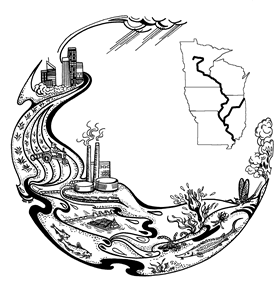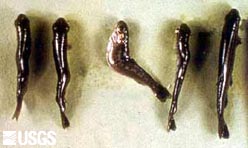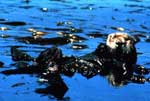- Home
- About S&T
- Taxa/Organisms
- Ecosystems
- Issues
- Methods & Tools
- Reports & Publications
- Location
- Search
September 2008 | Publisher: USGS | Format: URL
pubs.usgs.gov — Water is among Florida's most valued resources. The State has more than 1,700 streams and rivers, 7,800 freshwater lakes, 700 springs, 11 million acres of wetlands, and underlying aquifers yielding quantities of freshwater necessary for both human and environmental needs (Fernald and Purdum, 1998). Although renewable, these water resources are More...

2008 | Publisher: Other (RSC Publishing, Journal of Environmental Monitoring) | Format: URL
www.rsc.org — Environmental contaminant and biomarker monitoring data from major U.S. river basins were summarized for black bass (Micropterus spp.) and common carp (Cyprinus carpio) sampled over a nine year period. Cumulative frequency distributions revealed taxon differences for many organochlorine residue concentrations, elemental contaminant concentrations, More...

2006 | Publisher: USGS | Science Center: Upper Midwest Environmental Sciences Center (UMESC, LaCrosse) | Format: URL
www.umesc.usgs.gov — The Sediment-Contaminant Database for the Upper Mississippi River System (version 2) contains reliable sediment-contaminant data from a total of 3950 analyzed sediment samples collected from 1974 through 2000 from the Upper Mississippi River, the Illinois River, and selected tributary streams. Groups of contaminants represented in the database More...

Publisher: Other (San Francisco Estuary Institute (SFEI)) | Format: URL
sfei.org — The purpose of The Pulse is to make the most important information available on water quality in the San Francisco Estuary accessible to water quality managers, decision-makers, scientists, and the public. An article by USGS scientists Collin Eagles-Smith and Josh Ackerman on mercury bioaccumulation and effects on birds in San Francisco Bay More...

Publisher: Other (ScienceDirect (Elsevier)) | Format: URL
tinyurl.com — Organochlorine pesticide and total polychlorinated biphenyl (PCB) concentrations were measured in largemouth bass from the Tombigbee River near a former DDT manufacturing facility at McIntosh, Alabama. Concentrations of DDT isomers in McIntosh bass remained unchanged from 1974 to 2004 and were four times greater than contemporary concentrations More...

Publisher: USGS | Science Center: Western Fisheries Research Center (WFRC, Seattle) | Format: URL
wfrc.usgs.gov — This project addresses the occurrence of metal and organochlorine contaminant residues in commercial feeds purchased by the U.S. Fish and Wildlife Service (FWS) hatcheries. Research into fish feed quality could benefit all hatchery and aquaculture operations and assist in the interpretation of the effects of pollution on wild fish. Results from More...

Publisher: Other (Springer (Netherlands)) | Format: URL
tinyurl.com — Organochlorine chemical residues and elemental concentrations were measured in piscivorous and benthivorous fish at 111 sites from large U.S. river basins. Potential contaminant sources such as urban and agricultural runoff, industrial discharges, mine drainage, and irrigation varied among the sampling sites. Our objectives were to provide summary More...

Publisher: USGS | Science Center: Western Fisheries Research Center (WFRC, Seattle) | Format: URL
wfrc.usgs.gov — Bacterial kidney disease (BKD) is caused by Renibacterium salmoninarum and is considered to be the most difficult salmonid bacterial disease to control, in part because of its dual modes of transmission. This bacterium, unlike most other fish pathogens, is transmitted vertically from parent fish to progeny in association with the eggs, as well as More...

Publisher: USGS | Science Center: Western Fisheries Research Center (WFRC, Seattle) | Format: URL
wfrc.usgs.gov — There are approximately 500,000 abandoned mines in the western US. Collectively, these mines pollute rivers, streams, and western reservoirs with millions of tons of metals annually that degrade aquatic habitat and water used by humans for drinking, recreation, and irrigation. However, there is great potential in decreasing or eliminating the flow More...

Publisher: USGS | Science Center: Alaska Science Center (ASC, Anchorage) | Format: .PDF
www.absc.usgs.gov — An extensive and diverse array of studies were implemented concurrent with and for several years following the Exxon Valdez oil spill to determine the acute and chronic effects to sea otters. In part, this paper describes what activities relative to sea otters should take place prior to, during, and following another spill similar to the Exxon More...

Publisher: USGS | Science Center: Status & Trends | Format: URL
biology.usgs.gov — BEST evaluates environmental contaminants and their effects on species and lands under the stewardship of the Department of Interior to provide scientific information and guide management actions. The BEST Program provides the conceptual framework, leadership, and national coordination to identify spatial and temporal trends in contaminant More...

Publisher: USGS | Science Center: Western Ecological Research Center (WERC, Sacramento) | Format: URL
www.werc.usgs.gov — The Aleutian archipelago of Alaska, which separates the North Pacific Ocean from the Bering Sea, supports a diverse and abundant community of resident and migratory seabirds, comprising over 26 species and 10 million birds. However, comparatively little data exist on sources of environmental contaminants for this community despite extensive More...
